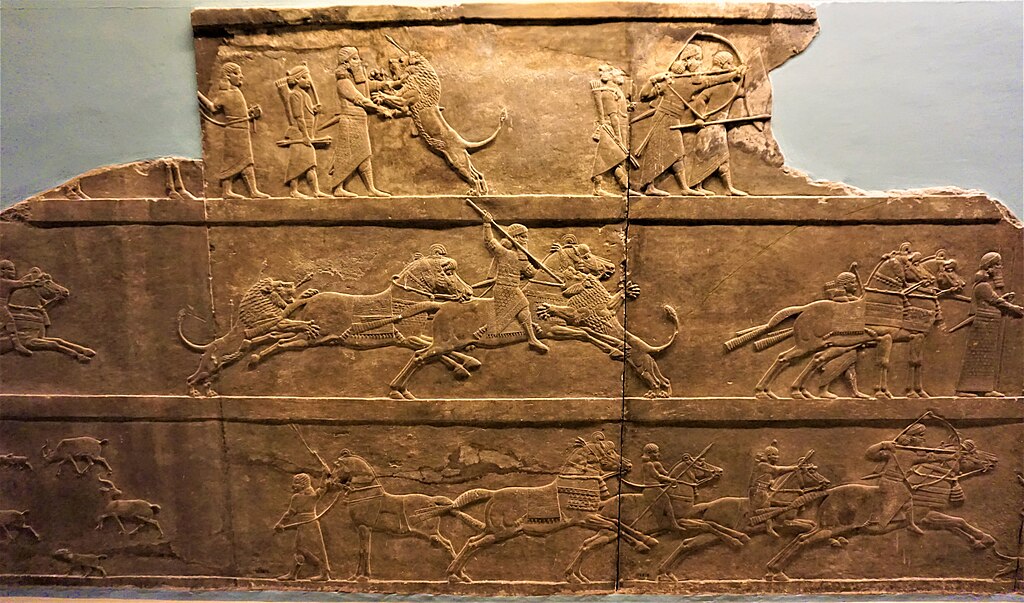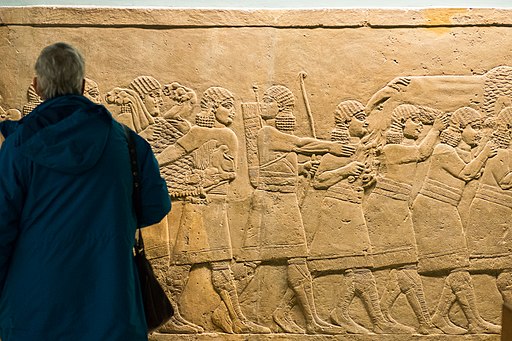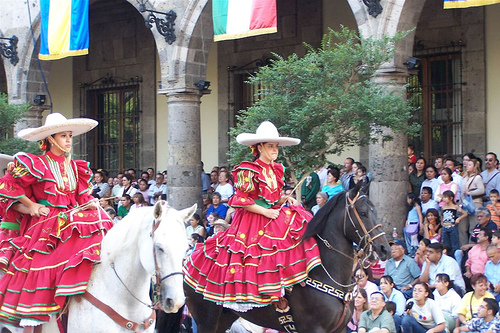
“The Lion Hunt” is a low relief sculpture showing the Royal Lion Hunt of King Ashurbanipal with his royal entourage, together with horses, dogs on leashes, and chariots.
The sculpture shows captured lions and lionesses being released from cages to do battle with the King. The Lion Hunt is one of the most captivating works of art from antiquity.
The suffering lions are depicted as brave and defiant, but they are eventually defeated with arrows, spears, and swords and are shown in individual suffering and dying in agony.
The ancient artist expertly captured the lions in motion depicting each animal as a unique individual. This intricate artistry was created over 2,500 years ago with primitive tools, and it is a masterpiece of Assyrian art.
These masterpieces were made about 645–635 BC, and originally formed different sequences placed around the palace. They may originally have been painted and formed part of a brightly colored Palace decor.
These images reinforced the power and majesty of the King. They represented a formalized ritual “hunt” in an arena, where captured Asian lions were released from cages for the king to slaughter.
There may have also been a religious or royal privilege dimension to the Lion hunt. An ancient clay tablet records that when a lion entered a house in the provinces, it had to be trapped and taken by boat to the king.
King Ashurbanipal reigned from 668 to 681 BC, and “The Lion Hunt” sculptures were discovered at his Palace of Nineveh in 1853 at the site of the ancient Assyrian capital of Nineveh.
Nineveh was the oldest and most populous city of the Assyrian Empire, which was located on the east bank of the Tigris opposite modern Mosul in Iraq.
King Ashurbanipal was the last great Assyrian leader. After his reign ended, the Empire descended into a period of civil war between his descendants, generals, and rebelling parts of the empire.
Less than 30 years after the Lion Hunt was created, the empire had fallen apart, and Nineveh been sacked and burnt.

Royal servants carrying the dead lions away (scale compared to human size)
Lion Hunting
Lion hunting has been an élite ritual since ancient times. In Ancient Egypt, lion hunts were usually reserved for pharaohs. These hunts nearly resulted in the extermination of lion populations in North Africa by 1100 BC.
Artworks have survived to show Pharaoh Amenhotep III killing more than 100 lions in a single hunt.
In ancient Assyria, lion hunting was a ritualized activity reserved for kings. These hunts were symbolic of the monarch’s duty to protect and fight for his people.
The Assyrian kings hunted lions for political and religious purposes, to demonstrate their power. The king would kill the lion from a chariot with his bow and arrow or spear. Meanwhile, spearmen and archers would always protect the king from the lion.
Lion hunting is also evident in Greek mythology and art. Lions were present in the Greek peninsula until classical times.
The prestige of lion hunting is demonstrated in Heracles’ first labor, the killing of the Nemean lion. Lions were depicted as prominent symbols of royalty, as in the Lion Gate to the citadel of Mycenae.
Today lion hunting is a subject of controversy as currently, the lion is listed as a vulnerable species, and some subspecies are listed as endangered. Fewer than 20,000 survive in the wild, a reduction of 60% in the last two decades.
There were estimated to be 1.2 million lions in 1880.

Detailed carvings of the Royal Chariot horses
Royal Lion Hunt of King Ashurbanipal
- Title: Royal Lion Hunt of King Ashurbanipal
- Material: Gypsum alabaster
- Sculptured: 645–635 BCE
- Excavated: 1852–54 CE
- Find site: Nineveh (near Mosul, in modern-day northern Iraq).
- Museum: The British Museum
Explore the Collections of the British Museum
Ancient Egypt and Sudan Collection
- The Rosetta Stone
- The Battlefield Palette 3100 BC
- Quartzite Head of the Egyptian Pharaoh Amenhotep III
- Colossal Granite Statue of Amenhotep III
- Hunters Palette
- Tomb of Nebamun
- Younger Memnon (Ramesses II)
The Assyrian Lion Hunt Reliefs
The Middle East Collection
- The Lion Hunt
- Cyrus Cylinder
- Royal Game of Ur
- Gilgamesh Flood Tablet
- Stela of Shamshi-Adad V
The palace decoration of Ashurbanipal
Ancient Greece and Rome Collection
- Marble figure of a Woman – Spedos Type
- The Parthenon Marbles
- The Parthenon Frieze
- Metopes of the Parthenon
- Pedimental Sculptures of the Parthenon
- The Erechtheion Caryatid
- Lion from the Mausoleum at Halicarnassus
- Bust of Pericles
- Aegina Treasure
- Townley Caryatid
- Bronze Statue of a Youth
- Thalia, Muse of Comedy
- Nereid Monument
- Sarcophagus of Seianti Hanunia Tlesnasa
Assyrian Lion Hunt at the British Museum
~~~
“Fear the goat from the front, the horse from the rear and man from all sides.”
– Assyrian Proverb
~~~
Photo Credits in order of above: 1) JOM; Paul Hudson from United Kingdom / CC BY (creativecommons.org/licenses/by/2.0)
Popular this Week








 Sponsor your Favorite Page
Sponsor your Favorite Page SEARCH Search for: Search Follow UsJoin – The JOM Membership Program
Sponsor a Masterpiece with YOUR NAME CHOICE for $5
Share this:
- Tweet
